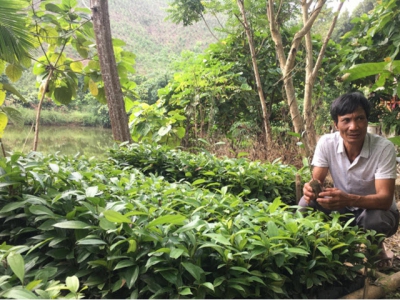Stable output for cinnamon tree

While many agricultural products struggle to find output during the Covid-19 epidemic season, cinnamon growers in Dinh Hoa district are relieved because they have units to buy them all.
Mr. Bui Van Hanh is a good farmer in production and business in Dinh Hoa district, Thai Nguyen province. Photo: Dong Van Thuong.
Mr. Luong Van Lanh, former Secretary of the Dinh Hoa District Party Committee (Thai Nguyen province), is considered the "architect" of the program to bring cinnamon in the Special National Site Safety Zone Dinh Hoa ('ATK Dinh Hoa').
Dinh Hoa has a large area of forest and forestry land, with potential for the economic development of hills and forests. However, people have not benefited much from the forest due to little planning, so people's lives are still facing many difficulties. The poverty rate is still high.
The policy of growing cinnamon was rekindled a decade ago, since 2010. As a result, the district has sent many delegations to visit and learn from the Yen Bai cinnamon area.
Regarding the locality, inviting businesses, functional departments, and a team of silviculture experts to grow and test together, cinnamon is especially suitable for the soil and climate here. Analysts also confirmed that the indexes of content and quantity of essential oils at each time and each stage of development of cinnamon are well higher than in other growing areas.
However, to have a stable and sustainable development, Dinh Hoa suggested that planting and processing enterprises develop a consumption roadmap, avoiding farmers switching to other crops.
Dinh Hoa district identifies cinnamon as a critical forestry tree. The district strives to reach 10 thousand hectares of cinnamon by 2030. The whole district grows over 500 hectares of cinnamon annually, increasing the forest coverage rate to 60% by 2025.
In the face of complicated developments of the Covid-19 epidemic, Dinh Hoa district encourages people to plant forests associated with forest product processing establishments, contributing to creating jobs, improving people's life quality and income, and fulfilling the goals of building new rural areas.
The People's Committee of Dinh Hoa district has cooperated with Vu Hoa Co., Ltd (Cho Chu town, Dinh Hoa) to implement growing cinnamon. The enterprise supports all initial investment costs (including seedlings and fertilizers), trains people on planting and caring techniques for cinnamon trees, and commits to purchasing all cinnamon products for oil processing.
To encourage people to participate in the project, the district has spent over VND 10.6 billion from the budget to support the entire cost of buying cinnamon seedlings for people.
After five years of implementation, the cinnamon growing project has been deployed to all areas. As a result, the whole district has grown over 2,300ha of cinnamon, mainly in the communes: Quy Ky, Linh Thong, Diem Mac, Son Phu, Binh Thanh, Tan Thinh, Tan Duong, Bao Cuong, Bao Linh.
Currently, cinnamon areas of ATK Dinh Hoa are at approximately 3000 hectares. Some 5-year-old cinnamon areas have begun to be exploited, providing a stable income for people.
Dinh Hoa district initially established a concentrated cinnamon material area to serve the local cinnamon oil extraction factory.
Mr. Luong Van Nhon (Na Lang hamlet, Phuong Tien commune) said that his family had 3.6 hectares of cinnamon forest planted since 2015. Last year, his family earned VND 35 million from selling cinnamon leaves. This year, the first 1 hectare of cinnamon harvested with the selling price of VND 1,400 per kilogram, his family earned VND 25 million. It is estimated that with 3.6 hectares, his family will make nearly VND 100 million.
There are few crops grown in mountainous areas with high economic value, like cinnamon. All can be used and sold at a high price, from the bark, branches, and stems to leaves. The economic benefits of cinnamon are entirely superior to other forest trees.
According to Mr. Pham Van Giang (Tham Yen village, Tan Thinh commune), for each hectare of acacia trees, after 7-10 years, the new harvest is VND 70-80 million. Meanwhile, in whole cinnamon, from the 6th to the 10th year, farmers earn VND 15-25 million per year from selling branches and leaves.
Having one of the largest cinnamon areas in Dinh Hoa district, Mr. Luan Duc Quynh, Chairman of Quy Ky Commune People's Committee, said that the commune currently has nearly 700 hectares of presence cinnamon trees. Of which, 250 hectares of cinnamon have been harvested, promising 7-8 times higher income than growing acacia.
Especially when other agricultural products are struggling to find output or have their prices dropped due to the impact of the Covid-19 epidemic, cinnamon products still have stable prices.
It can say that the policy of growing cinnamon is affirming its correctness, bringing great efficiency in economic and social development for people.
Mr. Hoang Van Thang, deputy head of the ATK Dinh Hoa Forest Protection Department, the district has the policy to support forest growers and businesses that consume raw materials, serving the goals of sustainable forestry development.
Có thể bạn quan tâm
 Strategy needed for vegetable exports to Europe
Strategy needed for vegetable exports to Europe Each year, this market imports about 35 billion euros, accounting for 45% of the global trade in fruit and vegetables. This is a potential market for Vietnamese
 Japan market share of dragon fruit needs to be maintained
Japan market share of dragon fruit needs to be maintained Some 2,000 tons of Vietnamese dragon fruit are exported to Japan annually, for a market share of over 80 per cent. Continuous improvements to quality
 Cao Phong orange specialized farming area builds consumption scenarios
Cao Phong orange specialized farming area builds consumption scenarios Cao Phong district, Hoa Binh province, has built orange consumption scenarios to adapt to the complicated development of the Covid-19 epidemic.